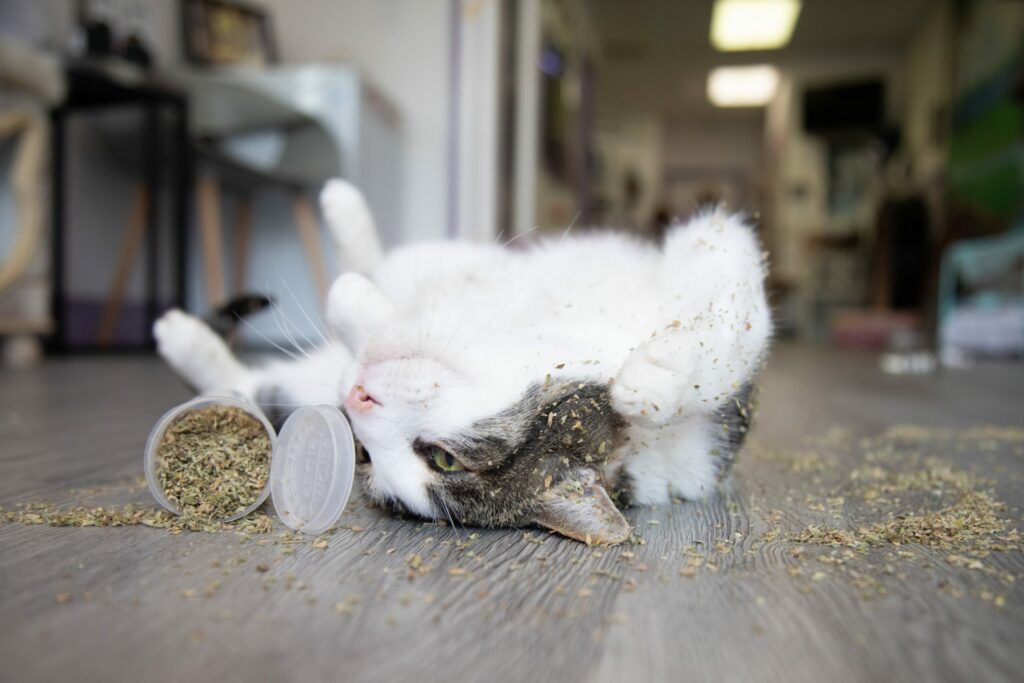Why does my cat love catnip?

Have you ever wondered why your furry friend goes bonkers over that little green herb known as catnip? The answer lies in the fascinating connection between your cat’s senses and the mysterious allure of Nepeta cataria, commonly known as catnip.
The Catnip Plant – Nature’s Cats Playground
Nepeta cataria, commonly known as catnip or catmint, belongs to the mint family, Lamiaceae. This herbaceous perennial is native to Europe and Asia, but it has made itself at home in many parts of the world.
With its distinctive heart-shaped leaves and clusters of white, lavender, or pink flowers, catnip adds a touch of beauty to any garden. Its resilience and adaptability make it a hardy plant that can flourish in various climates.
But what makes catnip truly special is its ability to induce a euphoric response in cats, leading to a range of amusing behaviors.
The history of cats’ fascination with catnip dates back centuries. Ancient Egyptians were among the first to observe the peculiar behavior of cats in the presence of catnip, recognizing its ability to induce a playful and euphoric response. Over time, this knowledge spread, and catnip became a staple in the gardens of cat lovers worldwide.
Understanding Nepetalactone
The secret behind catnip’s magical effect lies in a compound called nepetalactone. Found in the leaves, stems, and seeds of the catnip plant, nepetalactone acts as a feline pheromone, mimicking natural cat attractants.
Nepetalactone is a powerful compound that holds the key to the euphoric experience your cat undergoes. Found in the essential oils of the catnip plant, nepetalactone is a terpenoid, a type of organic compound that contributes to the distinctive scent and flavor of various plants.
Nepetalactone is a complex molecule, consisting of carbon, hydrogen, and oxygen atoms arranged in a specific configuration. This unique arrangement is what gives nepetalactone its extraordinary properties, making it the primary player in the catnip-catalyzed dance between cats and this humble herb.
The Catnip Encounter: A Whirlwind of Sensory Bliss
As your cat encounters catnip, their keen sense of smell kicks into high gear. The aromatic compounds, including nepetalactone, are released into the air, creating an olfactory symphony that is irresistible to our feline friends. The cat’s nostrils capture these volatile molecules, setting the stage for the next phase of the catnip experience.
Nepetalactone, once inhaled, binds to receptors in the sensory cells lining the nasal tissue of your cat. These receptors are part of the vomeronasal organ, also known as Jacobson’s organ, a specialized structure that detects pheromones and other chemical signals. Nepetalactone, with its unique structure, stimulates these receptors, initiating a cascade of neurological signals that travel to the brain.
As the signals reach the brain, a profound shift occurs in your cat’s behavior. The interaction between nepetalactone and the receptors triggers the release of neurotransmitters, including serotonin and dopamine, commonly associated with pleasure and reward. This chemical cascade results in the euphoric response that characterizes a cat’s interaction with catnip.
Catnip Sensitivity: The Genetic Factor
Catnip sensitivity is an inherited trait, passed down through generations in a manner reminiscent of other genetic characteristics. Researchers have identified a specific gene, dubbed the “catnip response gene”, that dictates a cat’s sensitivity to the effects of Nepeta cataria. This gene determines whether a cat will experience the euphoric response commonly associated with catnip exposure.
Statistics reveal that approximately 50-75% of cats exhibit a noticeable reaction to catnip. The wide variability in this percentage highlights the intricate nature of genetic inheritance. Kittens born to catnip-sensitive parents are more likely to share this trait, but it’s not a guaranteed outcome.
Interestingly, kittens and senior cats tend to show reduced responsiveness to catnip. While the genetic predisposition remains, younger cats may not exhibit strong reactions until they reach sexual maturity, usually around six months of age. On the flip side, as cats age, the intensity of their responses may diminish. This could be attributed to changes in their olfactory receptors or a general decrease in overall interest in play.
If you’ve ever offered catnip to your feline companion and received a nonchalant stare in return, don’t be disheartened. Around 25-50% of cats fall into the category of non-responders, showing little to no interest in catnip. This lack of sensitivity doesn’t indicate any health issues; it merely suggests a different genetic makeup.
Catnip Safety: Moderation is Key
Like any good thing, catnip is best enjoyed in moderation. While it’s true that the effects of catnip are temporary and harmless, overexposure can lead to a diminishing response over time. Cats can build a tolerance to the nepetalactone compound, resulting in a reduced sensitivity to catnip’s allure. Therefore, it’s essential to strike a balance in your cat’s catnip experiences.
To prevent desensitization, it’s advisable to offer catnip to your feline friend in moderation. Consider introducing catnip-infused toys or providing the herb itself no more than once a week. This measured approach allows your cat to retain their sensitivity, ensuring that each encounter with catnip remains a delightful and engaging experience.
Just as cats vary in their sensitivity to catnip, individual reactions can also differ. Some cats may become hyperactive and playful, while others might exhibit a more mellow response, resembling a state of blissful relaxation. Observe your cat’s reactions to catnip and tailor the frequency and quantity based on their preferences. This personalized approach ensures that your cat’s interactions with catnip align with their unique temperament.
The evolutionary origins of the cat attractant nepetalactone in catnip










